Gatehouse Media and The New York Times Co. have settled an inane lawsuit over Boston.com’s use of RSS feeds and story fragments from Gatehouse publications. You can read the muddled settlement term here (courtesy of Jeff Jarvis) and a very good analysis by Mark Potts here. It’s a good thing this suit didn’t go to court because it would have distracted both litigants – not to mention a few dozen journalism bloggers – from more important issues.
The conventional wisdom is that Gatehouse shot itself in the foot in this case by suing to end a practice that was driving traffic to its own websites from a much more visible competitor. In our opinion, Gatehouse had a legitimate gripe, but its mistake was paying lawyers to deal with a problem that could have been easily – and more beneficially – solved with technology. Basically, Gatehouse missed the opportunity to turn lemons into lemonade.
Instead of issuing a cease-and-desist, Gatehouse could have simply intercepted any traffic referred from a Boston.com URL and redirected it to a landing page. That page could have been used for anything Gatehouse wanted, such as a subscription promotion or even a redirect to the home page of the publication being linked to. Any 12-year-old can program a Web server to do this. So it’s perplexing why Gatehouse would want to bring in expensive and clueless attorneys to craft a solution that is so convoluted that no one will even pay attention to it two years from now.
Gatehouse actually had legitimate concerns about Boston.com’s use of its headlines and story summaries. The Boston Globe, which is Boston.com’s parent, was arguably compensating for its own cutbacks in suburban coverage by harvesting the work of a competitor. The problem is that challenging that practice legally is like trying to boil the ocean. Linking and summarizing are so intrinsic to the Web that legal action would be unenforceable and horribly expensive.
Had the suit actually gone to trial, everyone from the ACLU to the Electronic Frontier Foundation would have weighed in with an opinion and Gatehouse would have spent millions of dollars it doesn’t have to fight a battle that is probably costing its newspapers at most a few thousand dollars a year in lost revenue. It’s good that the Times Co. decided to just cave and settle. The agreement does no real harm to Boston.com and gives a few Gatehouse executives satisfaction. The only people who win are – ugh – the lawyers.
There’ll Always Be a France
People who think the U.S. government should subsidize newspapers might want to keep an eye on what’s happening in France, where the government has stepped up its financial support of the beleaguered newspaper industry. The French government already subsidizes newspapers to the tune of $360 million a year and now it will throw another $260 million in the annual kitty in the form of increased government ad spending and an unusual promotion that will give every 18-year-old a free newspaper subscription, presumably until he or she is no longer 18.
Keep in mind that France is about as much like the US as Mars is like the Earth. The French economy is highly regulated and the 35-hour work week is almost a state religion. The difference in perspective is well represented by this quote from President Nicolas Sarkozy: “It is the state’s primary responsibility to respond to an emergency, and there is an emergency caused by the impact of the collapse of advertising revenue.” Nevertheless, it’ll be interesting to see if government subsidies have any uplifting effect whatsoever on the French newspaper business, which appears to be in even worse shape than ours. We’re not betting on it.
Miscellany
Martin Langeveld has a terrific post at the Nieman Journalism Lab about why newspapers should get into social networking. Unfortunately, only about 10% of newspaper websites are doing anything in this area, according to one study. That’s puzzling, since newspapers can connect with their audiences geographically, which is something very few Web properties can do. We’ve wondered why sites like Going.com exist when newspapers are naturals to provide these location-based linkup services. Langeveld suggests that publishers are still having trouble shifting from the role of oracle to that of facilitator. The idea of enabling conversations instead of dominating them is still foreign. He’s probably right. See his post for an impressive list of links to resources that help explain how social media can help build community.
When Journal Register Co. bagged out of Connecticut earlier this month, one layoff victim decided to do something. Melissa Marinan, who sold advertising for JRC’s Imprint chain for 18 years, raised money from her dad and started her own local weekly called The Valley Press. She even recruited the former editor of the Imprint newspapers and hired a full-time reporter. Marinan will take care of selling advertising. The first issue of the free paper hits residents’ mailboxes on Feb. 5.
Reed Business Information is cutting about 7% of its workforce. The company publishes Variety and Publishers Weekly magazines, among others.
Thank you, Tim Windsor. The respect is mutual.
And Finally…
 Nigeria’s Vanguard newspaper reported matter-of-factly that police in Lagos implicated a goat (left, although not the actual goat in custody) in an attempted auto theft, saying that one of the thieves transformed himself into the animal in an attempt to avoid arrest. The thief was apprehended nonetheless, and now will either have to change back to a person or a spend the rest of his life in the, um, pen. If you don’t believe us, this story has been carried on hundreds of news sites. Oops, Gatehouse, there are those headlines and summaries again.
Nigeria’s Vanguard newspaper reported matter-of-factly that police in Lagos implicated a goat (left, although not the actual goat in custody) in an attempted auto theft, saying that one of the thieves transformed himself into the animal in an attempt to avoid arrest. The thief was apprehended nonetheless, and now will either have to change back to a person or a spend the rest of his life in the, um, pen. If you don’t believe us, this story has been carried on hundreds of news sites. Oops, Gatehouse, there are those headlines and summaries again.
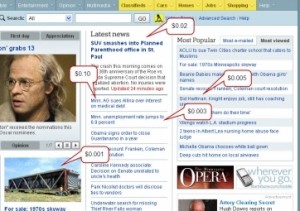


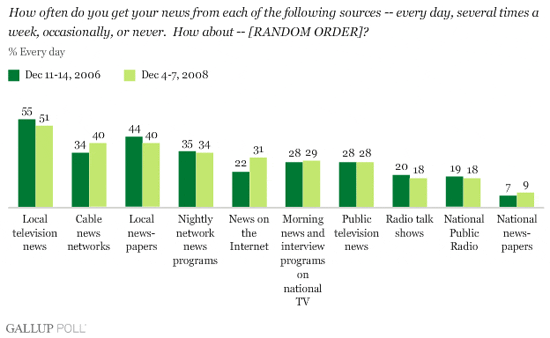

 Richard Pachter says the new book, The Man Who Owns the News: Inside the Secret World of Rupert Murdoch,
Richard Pachter says the new book, The Man Who Owns the News: Inside the Secret World of Rupert Murdoch, 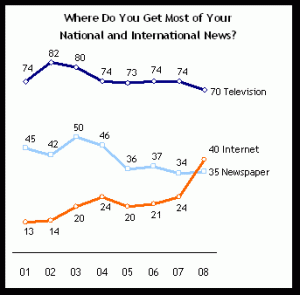 Last month we told you about new Gallup research that showed
Last month we told you about new Gallup research that showed 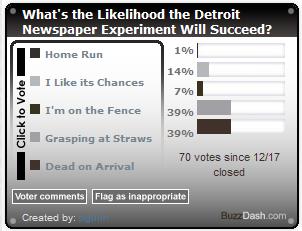

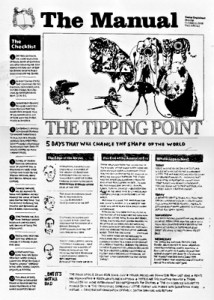 A team of enterprising publishers in the UK produced a four-page
A team of enterprising publishers in the UK produced a four-page 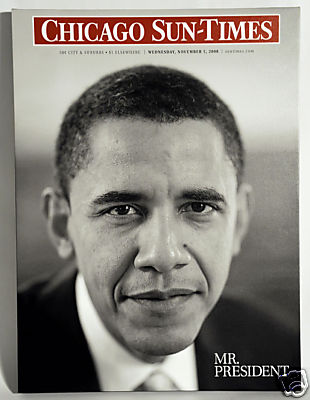 The Chicago Sun-Times
The Chicago Sun-Times 

 The Onion offered a tutorial in how to write a provocative magazine cover line (right).
The Onion offered a tutorial in how to write a provocative magazine cover line (right). The Simpsons showed its snotty character Nelson insulting a journalist. “Hah hah! Your medium is dying!”
The Simpsons showed its snotty character Nelson insulting a journalist. “Hah hah! Your medium is dying!” Editors at the Wine Spectator
Editors at the Wine Spectator 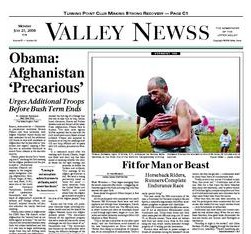
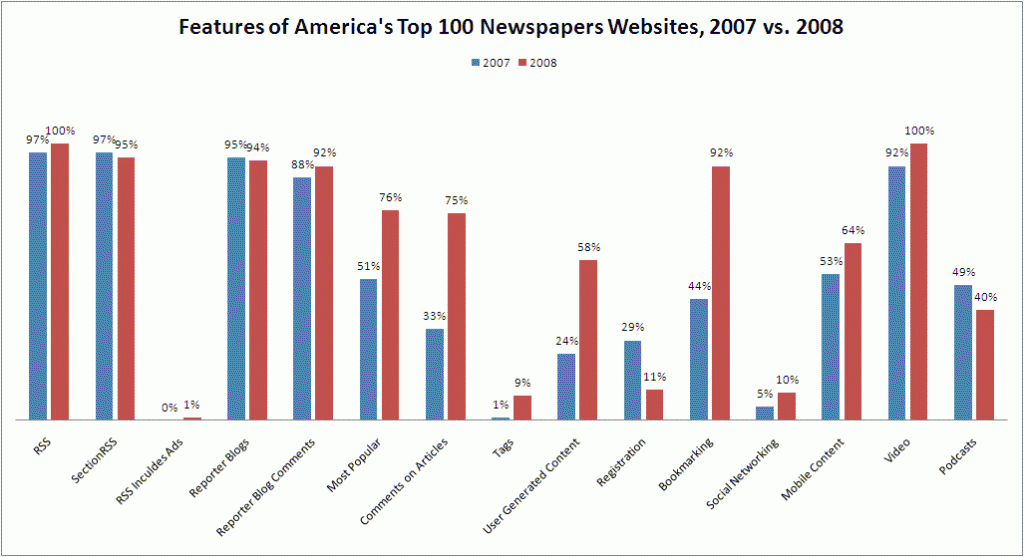
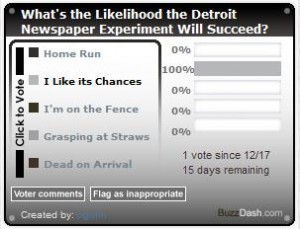
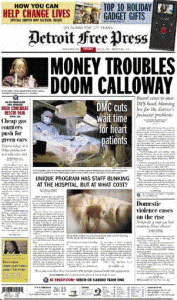
 No doubt there will be lots of analysis and reaction to follow. We see that Gannett Blog has logged 70 comments in the first four hours. We’ll keep an eye out. In the meantime, we couldn’t help taking a snapshot of the ad that appeared on the Detroit News‘s account of today’s announcement. Perhaps a cleansing is exactly what’s needed.
No doubt there will be lots of analysis and reaction to follow. We see that Gannett Blog has logged 70 comments in the first four hours. We’ll keep an eye out. In the meantime, we couldn’t help taking a snapshot of the ad that appeared on the Detroit News‘s account of today’s announcement. Perhaps a cleansing is exactly what’s needed.

